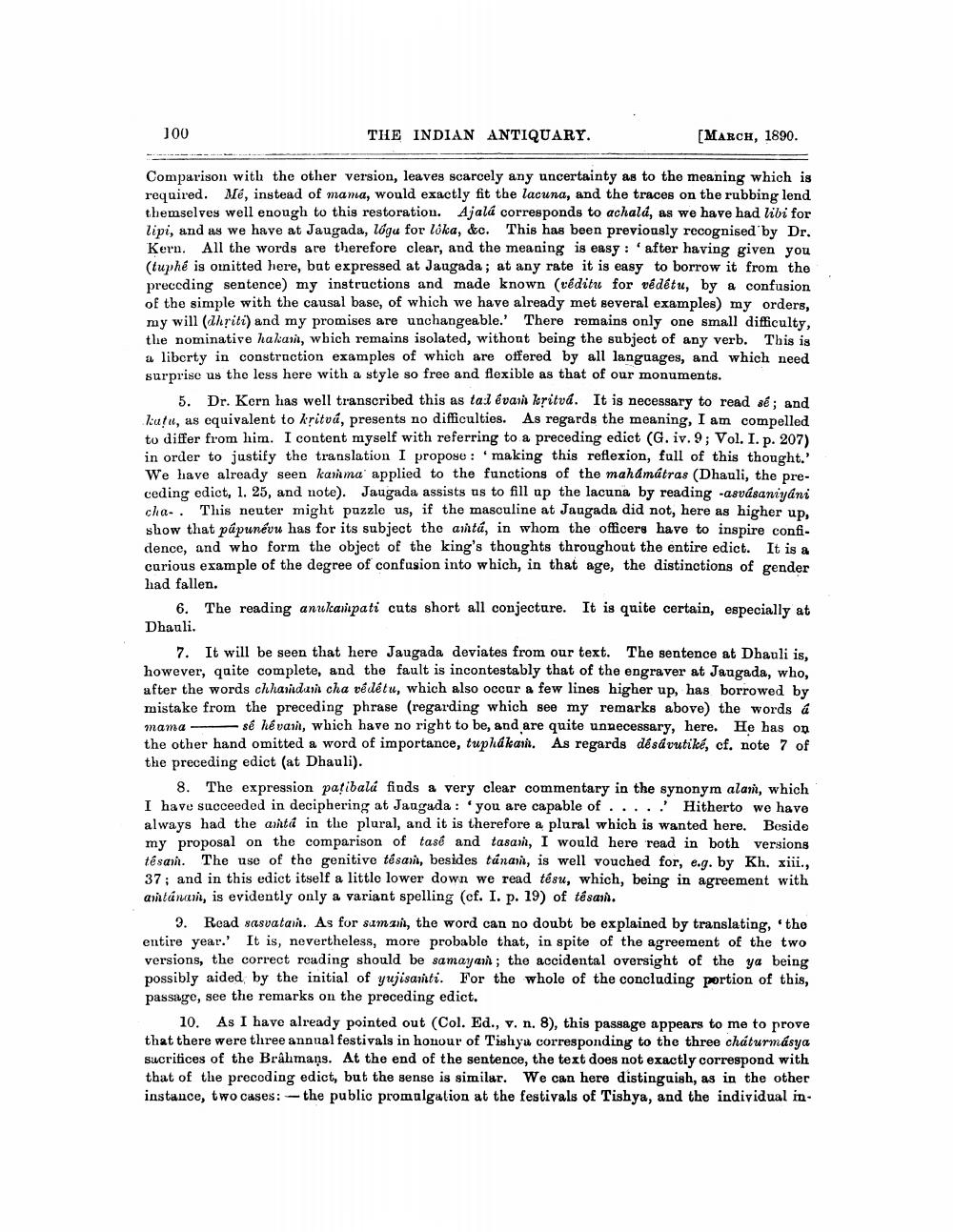________________
100
THE INDIAN ANTIQUARY.
[MARCH, 1890.
Comparison with the other version, leaves scarcely any uncertainty as to the meaning which is required. Mé, instead of mama, would exactly fit the lacuna, and the traces on the rubbing lend themselves well enough to this restoration. Ajalá corresponds to achald, as we have had libi for lipi, and as we have at Jaugada, lógu for lóka, &c. This has been previously recognised by Dr. Kern. All the words are therefore clear, and the meaning is easy : ' after having given you (tuphê is omitted here, but expressed at Jaugada; at any rate it is easy to borrow it from the preceding sentence) my instructions and made known (véditu for védétu, by a confusion of the simple with the causal base, of which we have already met several examples) my orders, my will (ahriti) and my promises are unchangeable. There remains only one small difficulty, the nominative hakarit, which remains isolated, without being the subject of any verb. This is a liberty in construction examples of which are offered by all languages, and which need surprise us the less here with a style so free and flexible as that of our monuments.
5. Dr. Kern has well transcribed this as ta: évari kritvd. It is necessary to read sé; and katu, as equivalent to kļitvá, presents no difficulties. As regards the meaning, I am compelled to differ from him. I content myself with referring to a preceding edict (G. iv. 9; Vol. I. p. 207) in order to justify the translation I propose : 'making this reflexion, full of this thought.' We have already seen karima' applied to the functions of the mahámátras (Dhauli, the preceding edict, 1. 25, and note). Jaugada assists as to fill up the lacuna by reading -asvásaniyani cha. This neuter might puzzle us, if the masculine at Jangada did not, here as higher up, show that pápunévu has for its subject the autá, in whom the officers have to inspire confi. dence, and who form the object of the king's thoughts throughout the entire edict. It is a carious example of the degree of confusion into which, in that age, the distinctions of gender had fallen.
6. The reading anulainpati cuts short all conjecture. It is quite certain, especially at Dhauli.
7. It will be seen that here Jaugada deviates from our text. The sentence at Dhauli is, however, quite complete, and the fault is incontestably that of the engraver at Jangada, who, after the words chhanduri cha védétu, which also occur a few lines higher up, has borrowed by mistake from the preceding phrase (regarding which see my remarks above) the words a mama sê hêvari, which have no right to be, and are quite unnecessary, here. He has on the other hand omitted a word of importance, tuphá kann. As regards désåvutiké, cf. note 7 of the preceding edict (at Dhauli).
8. The expression patibalá finds a very clear commentary in the synonym alam, which I have succeeded in deciphering at Jangada: 'you are capable of ..... Hitherto we have always had the anta in the plural, and it is therefore a plural which is wanted here. Beside my proposal on the comparison of tasé and tasar, I would here read in both versions tesani. The use of the genitive tesar, besides tánan, is well vouched for, e.g. by Kh. xiii., 37; and in this edict itself a little lower down we read tésu, which, being in agreement with antánan, is evidently only a variant spelling (cf. I. p. 19) of tésarn.
3. Read sasvatan. As for sam zin, the word can no doubt be explained by translating, the entire year.' It is, nevertheless, more probable that, in spite of the agreement of the two versions, the correct reading should be samayan; the accidental oversight of the ya being possibly aided by the initial of yujisanti. For the whole of the concluding portion of this, passage, see the remarks on the preceding edict.
10. As I have already pointed out (Col. Ed., v. n. 8), this passage appears to me to prove that there were three annual festivals in honour of Tishya corresponding to the three cháturmasya sucritices of the Brahmaņs. At the end of the sentence, the text does not exactly correspond with that of the precoding edict, but the sense is similar. We can here distinguish, as in the other instance, two cases: - the public promulgation at the festivals of Tishya, and the individual in




